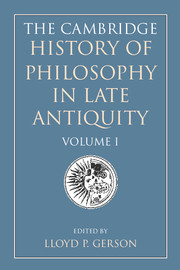Book contents
- Frontmatter
- General introduction
- I Philosophy in the later Roman Empire
- II The first encounter of Judaism and Christianity with ancient Greek philosophy
- III Plotinus and the new Platonism
- IV Philosophy in the age of Constantine
- Introduction to Part IV
- 20 Philosophy in a Christian empire: from the great persecution to Theodosius I
- 21 Themistius
- 22 The Alexandrian school. Theon of Alexandria and Hypatia
- 23 Hierocles of Alexandria
- V The second encounter of Christianity with ancient Greek philosophy
- Map 1 The Byzantine Empire, c. 500
22 - The Alexandrian school. Theon of Alexandria and Hypatia
from IV - Philosophy in the age of Constantine
Published online by Cambridge University Press: 28 May 2011
- Frontmatter
- General introduction
- I Philosophy in the later Roman Empire
- II The first encounter of Judaism and Christianity with ancient Greek philosophy
- III Plotinus and the new Platonism
- IV Philosophy in the age of Constantine
- Introduction to Part IV
- 20 Philosophy in a Christian empire: from the great persecution to Theodosius I
- 21 Themistius
- 22 The Alexandrian school. Theon of Alexandria and Hypatia
- 23 Hierocles of Alexandria
- V The second encounter of Christianity with ancient Greek philosophy
- Map 1 The Byzantine Empire, c. 500
Summary
The present chapter focuses on Hypatia of Alexandria and the school of thought she represented in fourth-century ce Alexandria. Nevertheless, defining what was Hypatia’s doctrine is rendered very difficult by the facts that we have no single source that can be attributed with certainty to her and that the only works she is reputed to have written bear on (apparently) ‘strictly mathematical’ topics. These are frustrating facts, given that various sources emphasize her considerable reputation both as a philosopher and as a local political figure. It is often taken for granted that Hypatia was a Platonist. But this presupposition relies on such disputable evidence that it is in fact no more than one possibility among many others. We shall see, in particular, that a more plausible one is that she basically was a Ptolemist, i.e., a dedicated follower of this original and composite philosophy elaborated by Ptolemy in the second century ce. One major reason for thinking so is that this philosophy had probably been already followed by her father Theon of Alexandria in the mid-fourth century ce, as well as by his predecessor Pappus of Alexandria at the beginning of the same century. Hypatia, Theon and Pappus obviously shared a deep interest in the study of Ptolemy’s Almagest, the two last having left influential commentaries on it. It is highly plausible (though not entirely provable, as we shall see) that this interest came along with the cultivation of the same kind of Ptolemism, derived from the philosophical commitment advocated by Ptolemy himself in his introduction to the Almagest, which gives a central role to the study of mathematics.
- Type
- Chapter
- Information
- The Cambridge History of Philosophy in Late Antiquity , pp. 417 - 436Publisher: Cambridge University PressPrint publication year: 2000
- 1
- Cited by



